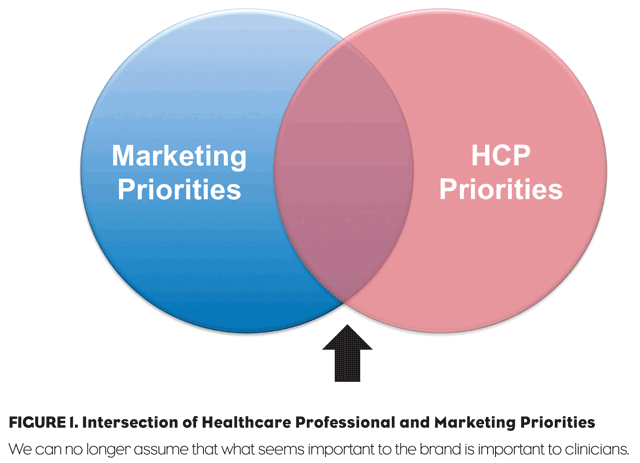Pharmaceutical marketing can be viewed as an exchange. The marketer provides physicians with useful information. In return, physicians offer their time—the time it takes to receive that information. If all works according to the marketing plan—this exchange serves both parties well. Marketers succeed in their mission to promote product use, and doctors are rewarded with knowledge that helps improve the quality of care they deliver.
Consider the differing daily priorities that motivate marketers and physicians today.
Professional brand marketers concentrate on one product at a time. They focus all of their energy on presenting messages about product benefits to clinicians. The goal is to ensure that doctors get the information they need to prescribe this drug with confidence.
So the marketer prioritizes reach and frequency, impact and persuasion. They invest countless hours in designing the call plan and perfecting the details of sales aids, journal ads, online promotion, professional websites, teaching decks and convention programs. They master the vagaries and nuances of regulatory review and approval.
Physicians see the world differently. They treat a wide variety of medical conditions and prescribe hundreds of products marketed by scores of drug companies. Their priority is effective, safe and responsible patient care. At the same time, they struggle to maintain a manageable work life. They strive to minimize the interruptions and hassles that threaten to turn every workday into a 12-hour marathon. They went into medicine to prevent illness, to diagnose and treat disease, only to discover a set of obstacles and roadblocks they did not anticipate, such as frustrating electronic medical records (EMRs) systems, Byzantine government regulations and diverse payer restrictions that mock their professional autonomy.
To bridge the gap between the worldview of the marketing team and the doctors they are trying to reach, most marketers commission extensive research and physician segmentation analysis. Most of this brand-funded research isolates their disease category in order to generate meaningful insights about the product and disease state in question. So this type of research rests on a potentially problematic assumption—the assumption that the doctors are interested in the details of the drug and the disease state in question. For example, segmentation studies categorize doctors based on their attitudes and behaviors with respect to a particular disease state. They rarely put those attitudes into the broader context of the physician’s entire work life. They do not ask, “Of the 10 most common conditions you treat, please rate this condition with respect to the relative amount of time and energy you devote to it.”
The medicinal product and the disease state have to be No. 1 in the mind of the brand marketing team. But what if it is number 175 out of 200 daily clinical decisions that doctors have to make. Physicians in research will spend an hour or more focusing exclusively on the topic at hand. But what about the broader context? What if those physicians are so harried that they cannot spend more than a minute or two with a rep or 10 to 20 seconds looking for brand information online?
Bridging the Gap
So there is a fundamental gap between the focus of brand marketers and the primary interests of the prescribers they need to reach. During a simpler time, before the era of information overload, doctors had the luxury to spend time with drug sales representatives. They were willing to have product information pushed at them. But times change.
Pharmaceutical companies no longer monopolize brand-related information and doctors often look elsewhere for prescription medication guidance. As a result, sales reps must cultivate a distinctive perspective towards professional marketing. While brand positioning and messaging, and the reach and frequency of promotional efforts remains vitally important, asking doctors another set of questions is vitally important. And those questions are shaped by seeing the world through the doctor’s eyes…
Ask:
- What is the physicians’ emotional valence for this disease category? Of this drug class?
- Where do their minds go first when this condition/drug comes up during the clinical encounter? Access and coverage? The discussion about side effects? Late-night calls about side effects? Confusion about dosing?
- Will doctors care about this new drug? Why?
- Do doctors perceive their dialogue with patients about this medication to be productive and efficient? Or time consuming and draining? How we can help facilitate the dialogue?
- How can we help make doctors more efficient?
- How can we influence patients to make doctors more efficient?
- What is the biggest hassle about treating this condition?
- Where will doctors look for help to address the hassle factor? What can we offer that is unique and distinctive?
Drug companies are not simply competing with other brands in the same class anymore. They are competing with the regulatory rules, financial details, time constraints and work priorities that shape the practice of medicine. Those factors conspire to push drug promotional messaging to the periphery of the doctor’s attention.
Earning Physician’s Attention
In this maelstrom, how do we earn physicians’ attention? We look for the overlap between brand benefits and physicians’ needs (Figure 1). The following four insights and related tactics exemplify the philosophy of starting the brand communications efforts based on physicians’ needs and interests rather than on brand messaging.
1. Physician as Cyborg. Physicians are spending more and more time interacting with computer screens, such as EMRs, smartphones, tablet PCs and laptop PCs. Are there ways to deliver unsolicited brand-related information onto this screen landscape aside from disruptive advertising? There are: One company has created a service that inserts product guidance and updates directly into the EMR whenever a physician orders the sponsor’s drug. Another company’s platform allows physicians to compare their patients’ data to a patient population of 64 million—and gives pharma brand managers the ability to learn more about what changes prescribing behaviors. Other services like this are going to emerge as EMR use becomes ubiquitous.
2. The Script is Written…Then What? Selecting a medication and writing the prescription is only the first step in the unpredictable sequence of medical therapy. Most brands develop one or more services to assist with access, co-pays, insurance issues and patient queries. But few try to streamline the constellation of services to minimize the headaches and obstacles to initiation of therapy and long-term compliance. Pharma brand managers should begin planning for a world where a “brand” is defined by a holistic customer experience that encompasses not only the drug/molecule, but the digital extension of the product itself—most likely in a mobile app. Think mobile startup kit. A digital experience that helps patients be as successful as possible on a product can and will influence physician prescribing behavior.
3. Up-to-Date. This represents a way that pharma brands can earn physicians’ attention and gratitude. While there is not always a steady stream of news about established products, there are always relevant advances in every medical specialty.
4. Productivity at the Point-of-Care. IBM’s powerful computer (Watson) may soon become a physician assistant. But you don’t need to have access to one of the world’s most powerful artificial intelligence machines to design and deliver helpful computational tools. Professional websites (especially mobile versions of these sites) can be turned into professional tools. Drug monitoring for interactions may be done this way, for example. But remember your brand is only one among many with which a physician interacts in a day. If you clutter your tools in promotional clinical trial data, you aren’t helping the physician at point-of-care. Saving a physician time can itself cause brand affinity. iPad services are emerging to help facilitate better conversations between physicians and patients, allowing docs to visually explain the condition or procedure to patients on their mobile devices. Brand managers should be looking to engage partners in that “holy grail” moment.
The gap between brand marketing and physicians’ interests will continue to widen, but the amount of help physicians will need to run a successful practice will also increase. This is creating a watershed moment for brand managers and their customers. Increasingly, all prescribing behaviors will be based completely on real-world data and the connectedness of physicians to each other—not promotional claims. In that world, how does a marketer influence brand preference?
By constantly asking ourselves when, where, why and how a doctor would look for, find and apply specific kinds of information, pharma can simultaneously serve the needs of the medical community while establishing a relationship between doctors and the brands we help promote.








